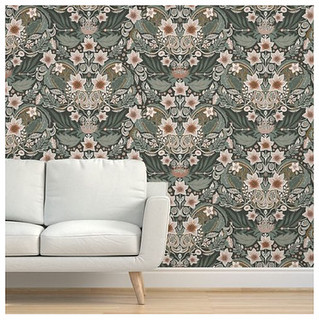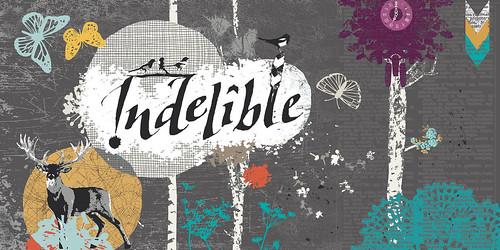My Eerie fabric collection is already shipping and available in shops, and before doing the regular post introduction about the collection, I have prepared this fun pumpkin block tutorial.
Decorative pillow covers are the easiest and fastest way to change your home décor without a major investment. Bold and funky patterns can sometimes feel overwhelming if used in larger home décor projects but can be fantastic for smaller-scale projects like pillows. They add a touch of color and pattern to your home space. Additionally, quilting adds texture and stability to the sewing/piecing, while trimming around the edges provides a modern look.
To get the printable template, download it HERE.
The featured fabrics: “Creepy Crawlers Tang”, “In The Dark”, “Creepy Crawlers Cement” and “Seeds Olive” by Katarina Roccella for Art Gallery Fabrics.
Materials
For 1 pillow, finished size 14" x 13.5”
(I suggest adding sashing/borders around if bigger size is needed)
-Fabrics:
Fabric A: Creepy Crawlers Tang, Fat quarter
Fabric B: In The Dark, Fat eight
Fabric C: Creepy Crawlers Cement, Fat eight
Fabric D: Seeds Olive, 2.5" square
Decorative trim (pipping or similar): 2 yds
-Medium weight, one-sided fusible interfacing or batting - 16 x 16” piece
-14"x14” pillow insert
-Cutting mat and rotary cuter
-Ruler
-Scissors
-Iron
-Needle and thread
-Sewing machine
-Pins, clips
-Fabric pencil or marker
CUTTING:
¼ seam allowances are included
Two (2) 2.5“ x 14.5” rectangles from Fabric A
Three (3) 2.5” squares from Fabric A
Eight (8) 2.75” squares from Fabric A
One (1) 2.5“ x 4.5” rectangle from Fabric A
Two (2) 2“ x 7.5” rectangles from Fabric A
Two (2) 3.5“ x 4.5” rectangles from Fabric A
Four (4) 2.75” x 4.75” rectangles from Fabric B
One (1) 2.5“ x 4.5” rectangle from Fabric B
Two (2) 2” squares from Fabric B
Four (4) 2.5” squares from Fabric C
Two (2) 2.5“ x 6.5” rectangles from Fabric C
One (1) 2.5“square from Fabric D
Pillow front: pumpkin block
Guided by the cutting and fabric requirements, make 4 Flying geese units.
• Prepare the 2 ¾” (2.75") squares in fabric A for the wings and 2 ¾” x 4 ¾” (2.75” x 4.75”) in fabric B for the geese body to make the FG units. Mark a diagonal line across the wrong side of all 2 ¾” squares. Place one square on the right corner of a corresponding rectangle, right sides together. Stitch across the corner on the line. Trim off corner, leaving a 1/4" seam. Press corner up.
Place another square on the left corner of the same rectangle, right sides together. Note that the second square will overlap the first one (that’s because you need to obtain the ¼” seam allowance at the top of
the triangle’s point). Stitch across the corner on the marked line. Trim off corner, leaving a 1/4" seam.
Press corner up. After all the FG units are sewn together, trim them to obtain 2 ½ ”x 4 ½ “ units.
Flippy corners on rectangles (row 2, 4 and 6):
• With wrong side up, mark all 2”corner squares in fabric B and 2.5”corner squares in fabric C in half
diagonally to determine the central - sew line.
• Paying close attention to the orientation of each corner square: place and align them on the
corresponding 2” x 7.5“ (row 4) and 2.5” x 14.5“ rectangles (for row 2 and 6) in fabric A and sew along the central diagonal line.
• Trim off corners, leaving a 1/4” seam allowance, press seams as desired, flipping the corner.
More about flying geese construction and floppy corners, you can learn HERE.
Adding the trim
With right side of the pillow front up, start pinning the trim all way around, starting from one corner and rounding it slightly on all corners. Sew the trimming in place, with the smallest seam allowance possible, finishing where you started, overlapping the trim’s edges.
Note: there are different weights, qualities and sizes of the trims, and depending on that, you may be able or not to slightly round the corners for the nice and professional finish. Thinner and softer trimmings are more suitable for shaping, while with thicker trimmings, you may be forced to cut the trimming separately for each of the pillow’s edges and overlap the edges on all corners.
Pillow back
The easiest way to make the pillow back is with simple envelope back.
Take the rectangles cut for the pillow back (2 Fat quarters), fold and press them on the longer side (22”) in half, wrong sides inside, so that you obtain two 18 x 11” pieces.
Pillow assemble
Overlap the back pieces, squaring them and place the pillow front with right side inside-facing the overlapped backs. Pin all layers together and cut the backs leftover edges to the size of the pillow front- 14.5" x 14”. Sew around all edges with ¼ seam allowance, rounding the corners slightly, to prevent protruding. Turn the pillow case right side out and place the pillow insert inside.








































 GRID
GRID
 DECADENCE
DECADENCE





















































21 comments :
Impressive website. Numerous helpful tips in this article. Excellent activity!
Just wish to say your article is as astonishing. Please continue the gratifying work.
"What a beautiful and cozy pumpkin quilt block design! The colors you chose really capture the essence of fall, and the craftsmanship is impressive. chuys coupon code
Your post has definitely inspired me to use some of those deals for a similar project. Thanks for the inspiration, and happy quilting! speedycash promo code
it is here for all of Digitizing Services here for it ^%^$646$#53564^
Looking for the best SEO agency in Melbourne? My Digital Solutions offers expert SEO services to help your business rank higher on search engines. Increase your online visibility and attract more customers.
Luminii Events is the best team building company in Dubai. We organize fun and practical activities that help teams work better together. Our expert team ensures your event is successful and memorable. Call now.
Wonderful!
What a charming pumpkin quilt block design! The colors and details are perfect for creating a cozy autumn vibe. Seaside Serenity: The Top 5 One-Piece Swimwear and Cover-Up Combinations
This pumpkin quilt block pillow front is absolutely stunning! The design is perfect for adding a cozy, seasonal touch to any home. Your choice of colors and patterns is so inspiring. Dazzle in Red: 7 Stunning Dresses You Need in Your Closet
Falcon is the best platform for invoice discounting in India. It helps businesses get quick funds by using unpaid invoices. The process is simple, fast, and secure. Choose Falcon to grow your business with easy access to working capital through invoice discounting.
Looking for AC installation in Bhubaneswar? O Care 365 offers fast and reliable AC installation services at your home or office. Our experts ensure proper fitting for the best cooling. Call us today for a hassle-free AC setup at an affordable price.
What a cozy and charming project—the pumpkin quilt block is absolutely perfect for the season! At Spire Building Supplies, we admire the kind of creativity and care that goes into handcrafted work like this. Beautifully done and truly heartwarming!
What a creative pillow tutorial! Just like you carefully piece together your pumpkin quilt block, Feynix Solution crafts websites and apps with precision, and also provides expert SEO and digital marketing services to help businesses grow online.
Love the attention to detail in this pumpkin block! Uniqent makes high-quality gloves, jackets, and welding guards that protect professionals while they work—just like your precise piecing protects the integrity of the quilted pillow.
Fantastic pillow project! Strong Arm Welding offers durable jackets, gloves, welding guards, and aprons that keep workers safe during tough tasks, similar to how your careful quilting ensures a perfect, long-lasting pillow finish.
Wow! This pumpkin quilt block pillow looks absolutely charming and so cozy. I love the colors and the stitching details—they really make it special. Reading this made me think of enjoying it with a little treat, maybe something like a Chicken Zinger Roll—perfect combo for a relaxing craft day! Thanks for sharing such a lovely idea!
After switching to a Sliding Vinyl Window, we noticed reduced heating and cooling costs. The design is sleek, modern, and it operates smoothly without any noise.
Had a beef bihari roll today and wow! The meat was tender, spices well-balanced, and the roll packed with flavor. Definitely worth trying again.
investment projects in Montenegro in real estate and hospitality sectors are booming. Strategic locations like Budva and Kotor guarantee excellent long-term growth.
For anyone serious about welding, the best TIG welding gloves are essential. They’re heat-resistant, flexible, and reliable for long-term use.
Post a Comment